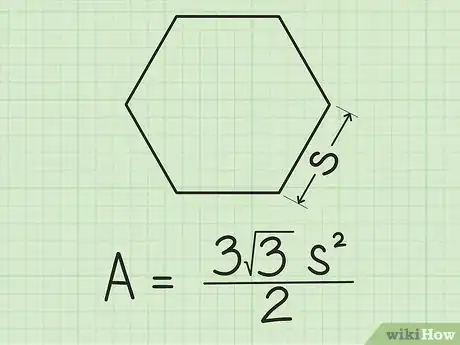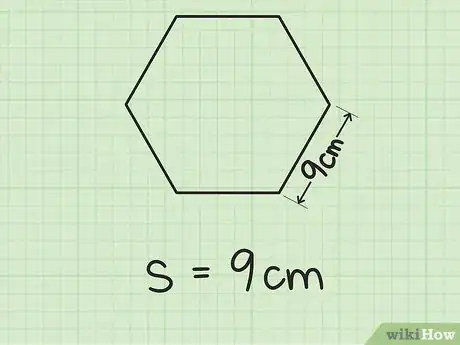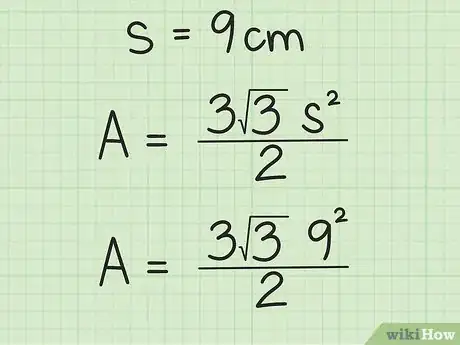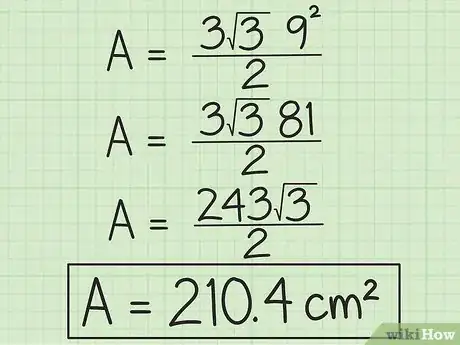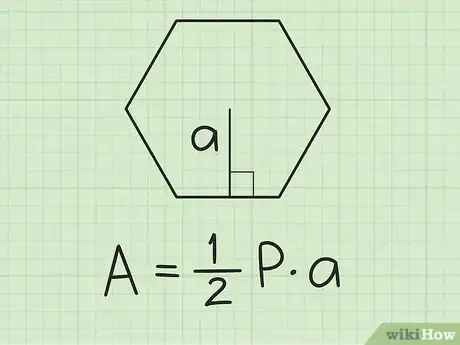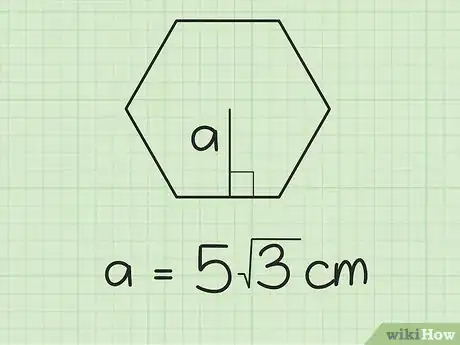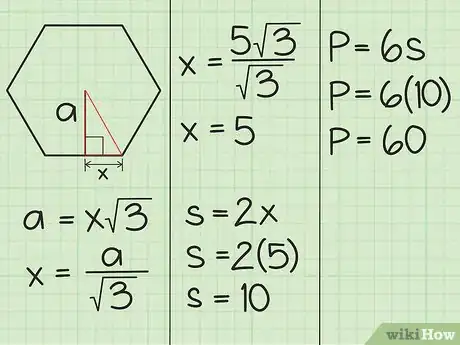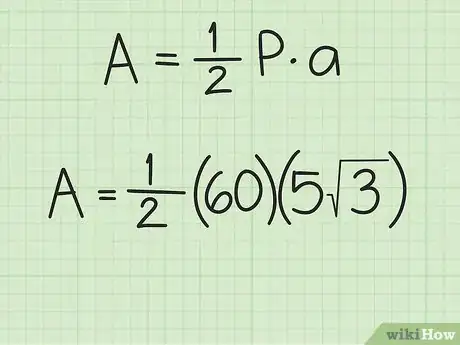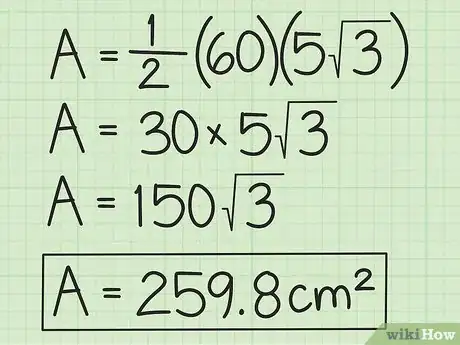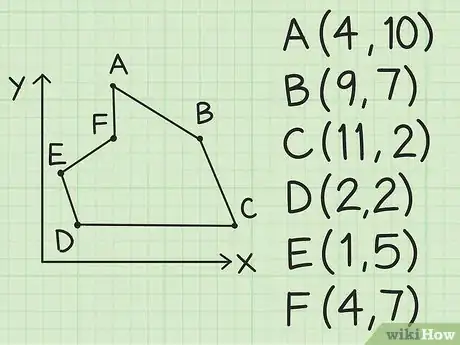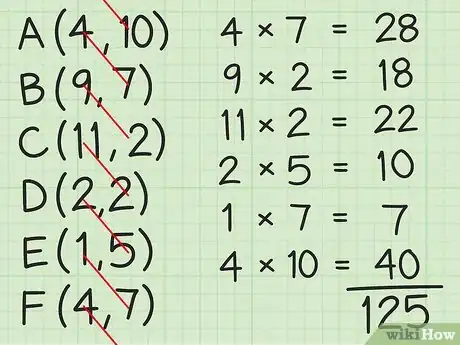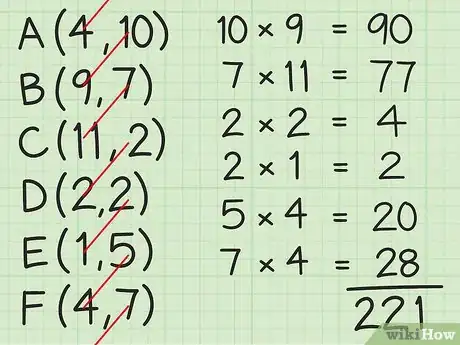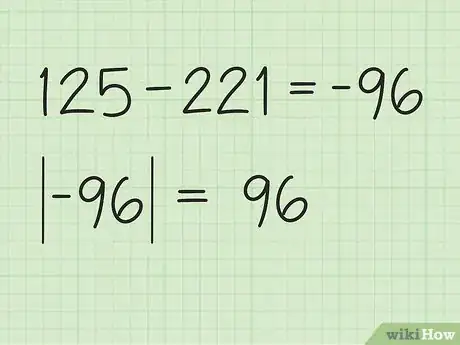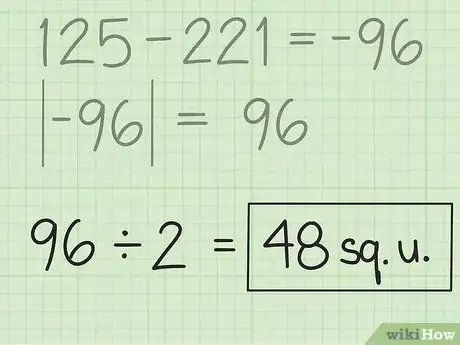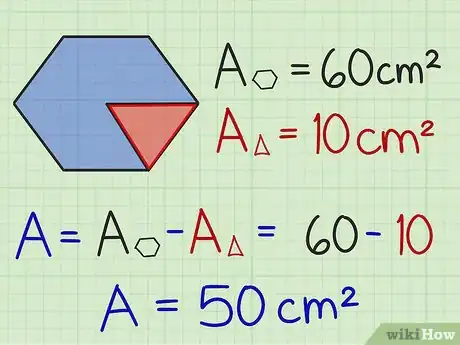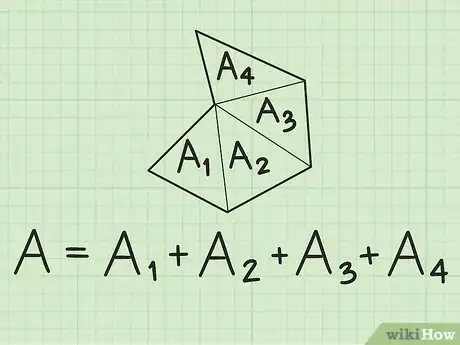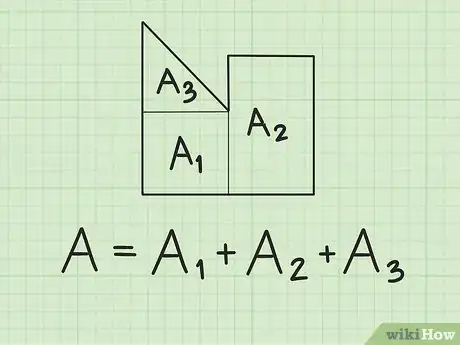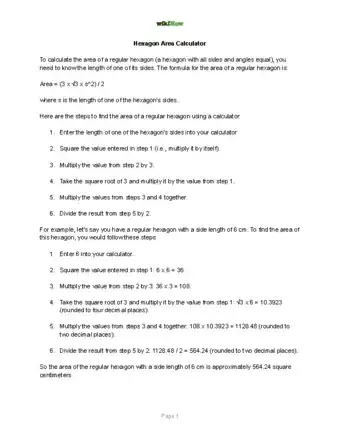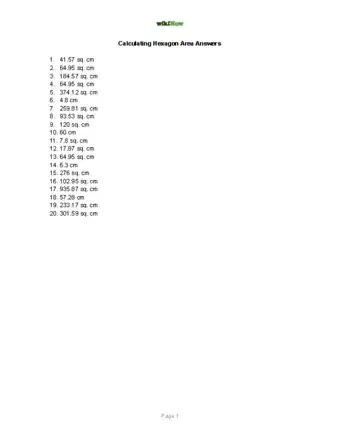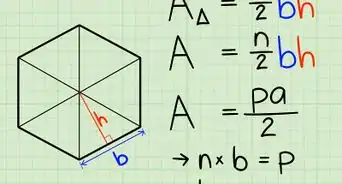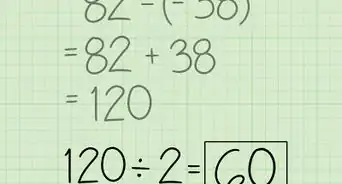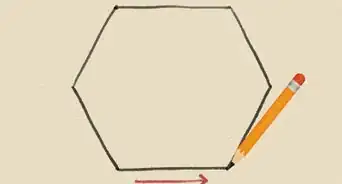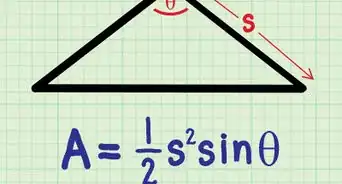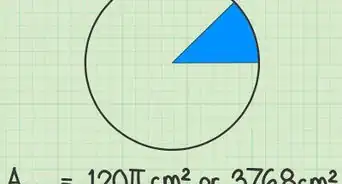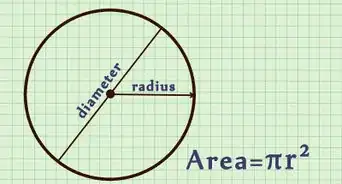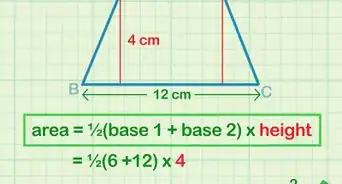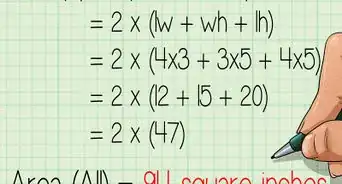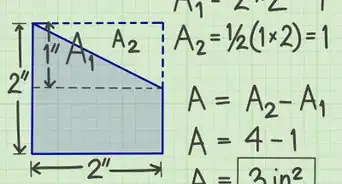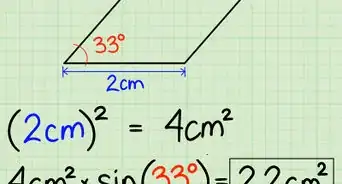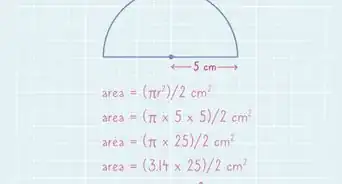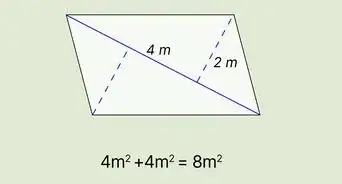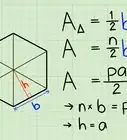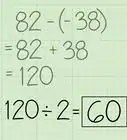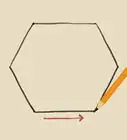wikiHow is a “wiki,” similar to Wikipedia, which means that many of our articles are co-written by multiple authors. To create this article, 35 people, some anonymous, worked to edit and improve it over time.
There are 8 references cited in this article, which can be found at the bottom of the page.
This article has been viewed 1,384,734 times.
Learn more...
A hexagon is a polygon that has six sides and angles. Regular hexagons have six equal sides and angles and are composed of six equilateral triangles. There are a variety of ways to calculate the area of a hexagon, whether you're working with an irregular hexagon or a regular hexagon. If you want to know how to calculate the area of a hexagon, just follow these steps.
Steps
Calculating from a Regular Hexagon with a Given Side Length
-
1Write down the formula for finding the area of a hexagon if you know the side length. Since a regular hexagon is comprised of six equilateral triangles, the formula for finding the area of a hexagon is derived from the formula of finding the area of an equilateral triangle. The formula for finding the area of a hexagon is Area = (3√3 s2)/ 2 where s is the length of a side of the regular hexagon.[1]
-
2Identify the length of one one side. If you already know the length of a side, then you can simply write it down; in this case, the length of a side is 9 cm. If you don't know the length of a side but know the length of the perimeter or apothem (the height of one of the equilateral triangles formed by the hexagon, which is perpendicular to the side), you can still find the length of the side of the hexagon. Here's how you do it:
- If you know the perimeter, then just divide it by 6 to get the length of one side. For example, if the length of the perimeter is 54 cm, then divide it by 6 to get 9 cm, the length of the side.[2]
- If you only know the apothem, you can find the length of a side by plugging the apothem into the formula a = x√3 and then multiplying the answer by two. This is because the apothem represents the x√3 side of the 30-60-90 triangle that it creates. If the apothem is 10√3, for example, then x is 10 and the length of a side is 10 * 2, or 20.
Advertisement -
3Plug the value of the side length into the formula. Since you know that the length of one side of the triangle is 9, just plug 9 into the original formula. It will look like this: Area = (3√3 x 92)/2
-
4Simplify your answer. Find the value of equation and write the numerical answer. Since you're working with area, you should state your answer in square units. Here's how you do it:[3]
- (3√3 x 92)/2 =
- (3√3 x 81)/2 =
- (243√3)/2 =
- 420.8/2 =
- 210.4 cm2
Calculating from a Regular Hexagon with a Given Apothem
-
1Write down the formula for finding the area of a hexagon with a given apothem. The formula is simply Area = 1/2 x perimeter x apothem.[4]
-
2Write down the apothem. Let's say the apothem is 5√3 cm.
-
3Use the apothem to find the perimeter. Since the apothem is perpendicular to the side of the hexagon, it creates one side of a 30-60-90 triangle. The sides of a 30-60-90 triangle are in the proportion of x-x√3-2x, where the length of the short leg, which is across from the 30 degree angle, is represented by x, the length of the long leg, which is across from the 60 degree angle, is represented by x√3, and the hypotenuse is represented by 2x.[5]
- The apothem is the side that is represented by x√3. Therefore, plug the length of the apothem into the formula a = x√3 and solve. If the apothem's length is 5√3, for example, plug it into the formula and get 5√3 cm = x√3, or x = 5 cm.
- By solving for x, you have found the length of the short leg of the triangle, 5. Since it represents half the length of one side of the hexagon, multiply it by 2 to get the full length of the side. 5 cm x 2 = 10 cm.
- Now that you know that the length of one side is 10, just multiply it by 6 to find the perimeter of the hexagon. 10 cm x 6 = 60 cm
-
4Plug all of the known quantities into the formula. The hardest part was finding the perimeter. Now, all you have to do is plug the apothem and perimeter into the formula and solve:
- Area = 1/2 x perimeter x apothem
- Area = 1/2 x 60 cm x 5√3 cm
-
5Simplify your answer. Simplify the expression until you've removed the radicals from the equation. State your final answer in square units.[6]
- 1/2 x 60 cm x 5√3 cm =
- 30 x 5√3 cm =
- 150√3 cm =
- 259. 8 cm2
Calculating from an Irregular Hexagon with Given Vertices
-
1List the x and y coordinates of all the vertices. If you know the vertices of the hexagon, the first thing you should do is create a chart with two columns and seven rows. Each row will be labeled by the names of the six points (Point A, Point B, Point C, etc), and each column will be labeled as the x or y coordinates of those points. List the x and y coordinates of Point A to the right of Point A, the x and y coordinates of Point B to the right of Point B, and so on. Repeat the coordinates of the first point at the bottom of the list. Let's say you're working with the following points, in (x, y) format:[7]
- A: (4, 10)
- B: (9, 7)
- C: (11, 2)
- D: (2, 2)
- E: (1, 5)
- F: (4, 7)
- A (again): (4, 10)
-
2Multiply the x coordinate of each point by the y coordinate of the next point. You can think of this as drawing a diagonal line to the right and downward one row from each x coordinate. List the results to the right of the chart. Then, add the results.[8]
- 4 x 7 = 28
- 9 x 2 = 18
- 11 x 2 = 22
- 2 x 5 = 10
- 1 x 7 = 7
- 4 x 10 = 40
- 28 + 18 + 22 + 10 + 7 + 40 = 125
-
3Multiply the y coordinates of each point by the x coordinates of the next point. Think of this as drawing a diagonal line from each y coordinate downward and to the left, to the x coordinate below it. Once you multiply all of these coordinates, add the results.[9]
- 10 x 9 = 90
- 7 x 11 = 77
- 2 x 2 = 4
- 2 x 1 = 2
- 5 x 4 = 20
- 7 x 4 = 28
- 90 + 77 + 4 + 2 + 20 + 28 = 221
-
4Subtract the sum of the second group of coordinates from the sum of the first group of coordinates.[10] Just subtract 221 from 125. 125 - 221 = -96. Now, take the absolute value of this answer: 96. Area can only be positive.
-
5Divide this difference by two.[11] Just divide 96 by 2 and you'll have the area of the irregular hexagon. 96/2 = 48. Don't forget to write your answer in square units. The final answer is 48 square units.
Other Methods for Calculating the Area of an Irregular Hexagon
-
1Find the area of a regular hexagon with a missing triangle. If you know you're working with a regular hexagon that is missing one or more of its triangles, then the first thing you need to do is find the area of the entire regular hexagon as if it were whole. Then, simply find the area of the empty or "missing" triangle, and that subtract that from the overall area. This will give you the area of the remaining irregular hexagon.[12]
- For example, if you've found that the area of the regular hexagon is 60 cm2 and you've found that the area of the missing triangle is 10 cm2 simply subtract the area of the missing triangle from the entire area: 60 cm2 - 10 cm2 = 50 cm2.
- If you know that the hexagon is missing exactly one triangle, you can also just find the area of the hexagon by multiplying the total area by 5/6, since the hexagon is retaining the area of 5 of its 6 triangles. If it's missing two triangles, you can multiply the total area by 4/6 (2/3), and so on.
-
2Break up an irregular hexagon into other triangles. You may find that the irregular hexagon is actually composed of four triangles that are irregularly shaped. To find the area of the whole irregular hexagon, you need to find the area of each individual triangle and then add them up. There are a variety of ways to find the area of a triangle depending on the information that you have.[13]
-
3Look for other shapes in the irregular hexagon. If you can't simply pick apart a few triangles, look through the irregular hexagon to see if you can locate other shapes -- maybe a triangle, a rectangle, and/or a square. Once you've outlined the other shapes, just find their areas and add them up to get the area of the entire hexagon.[14]
- One type of irregular hexagon is comprised of two parallelograms. To get the areas of the parallelograms, just multiply their bases times their heights, just as you would do to find the area of a rectangle, and then add up their areas.
Hexagon Area Calculator, Practice Problems, and Answers
Community Q&A
-
QuestionI was only given the length of the diagonal. What do I do?
 Community Answer1/3rd of the length of the diagonal is the side of the hexagon. Using this, you can calculate the area.
Community Answer1/3rd of the length of the diagonal is the side of the hexagon. Using this, you can calculate the area. -
QuestionI know the area, nothing else. I need a regular hexagon. What do I do?
 DonaganTop AnswererAssuming you're looking for the length of a side, solve for s using the area formula in Method 1 above. Then plug in the known area.
DonaganTop AnswererAssuming you're looking for the length of a side, solve for s using the area formula in Method 1 above. Then plug in the known area. -
QuestionWhat is the area of a regular hexagon where the length of each side is 7m?
 Community AnswerThe side is 1/2 of 7 = 3.5. The area of a regular hexagon is (3√3 *3.5^2)/2 =31.82 or 32 cm, approximately.
Community AnswerThe side is 1/2 of 7 = 3.5. The area of a regular hexagon is (3√3 *3.5^2)/2 =31.82 or 32 cm, approximately.
References
- ↑ https://www.cuemath.com/measurement/area-of-a-hexagon/
- ↑ https://sciencing.com/calculate-length-sides-regular-hexagons-6001248.html
- ↑ https://www.varsitytutors.com/high_school_math-help/how-to-find-the-area-of-a-hexagon
- ↑ https://www.mathsisfun.com/geometry/regular-polygons.html
- ↑ http://jwilson.coe.uga.edu/emat6680/parsons/mvp6690/unit/hexagon/hexagon.html
- ↑ https://www.cuemath.com/measurement/area-of-a-hexagon/
- ↑ http://www.mathopenref.com/coordpolygonarea.html
- ↑ https://www.mathopenref.com/coordpolygonarea.html
- ↑ https://www.mathopenref.com/coordpolygonarea.html
About This Article
To calculate the area of a hexagon, use the formula a = 3 × square root of 3 × s^2 divided by 2, where a is the area and s is the length of a side of the hexagon. Just plug in the length of one of the sides and then solve the formula to find the area. If you don't have one of the side lengths but you do have the apothem, you can use the formula a = 1/2 × perimeter × apothem, where a is the area. To learn more, like how to calculate the area of an irregular hexagon, keep reading the article!
